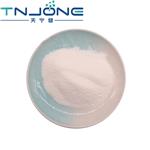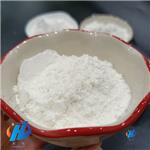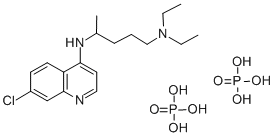Chloroquine Diphosphate: Adverse Effects and Degradation Pathways
Feb 4,2024
General Description
Chloroquine diphosphate, an antimalarial drug, can cause various adverse effects on ocular, immune, ear and labyrinth, musculoskeletal and connective tissue, gastrointestinal, skin, mental health, and cardiovascular systems. The drug is also susceptible to degradation through hydrolysis, oxidation, photodegradation, and interaction with other substances, which can affect its stability and efficacy. Proper storage and avoidance of co-administration with interacting substances are important for minimizing degradation. Understanding the degradation pathways of chloroquine diphosphate is crucial for ensuring its quality, efficacy, and safety. Healthcare professionals should be aware of these potential adverse effects and degradation processes when prescribing and dispensing the drug.

Figure 1. Chloroquine diphosphate
Adverse Effects
Chloroquine diphosphate, an antimalarial drug, can have various adverse effects. However, it is important to note that the frequency of these effects is not precisely defined. Ocular disorders associated with chloroquine diphosphate include maculopathy (damage to the central part of the retina), macular degeneration, visual disturbances, nyctalopia (night blindness), and scotomatous vision with field defects of paracentral and pericentral ring types. These field defects often manifest as temporal scotomas, causing difficulties in reading, words appearing to disappear, seeing only half of an object, misty vision, and a sensation of fog before the eyes. Additionally, reversible corneal opacities may occur. Adverse effects on the immune system may include urticaria (hives) and anaphylactic reactions, such as angioedema (swelling under the skin). Ear and labyrinth disorders associated with chloroquine diphosphate use include nerve-type deafness, tinnitus (ringing in the ears), and reduced hearing, particularly in individuals with preexisting auditory damage. Musculoskeletal and connective tissue disorders can manifest as sensorimotor disorders, skeletal muscle myopathy or neuromyopathy, depression of tendon reflexes, and abnormal nerve conduction. Gastrointestinal disorders may include hepatitis (inflammation of the liver), increased liver enzymes, anorexia (loss of appetite), nausea, vomiting, diarrhea, and abdominal cramps. Skin-related adverse effects may comprise erythema multiforme, Stevens-Johnson syndrome, toxic epidermal necrolysis, exfoliative dermatitis, pleomorphic skin eruptions, skin and mucosal pigment changes, lichen planus-like eruptions, pruritus (itching), drug rash with eosinophilia and systemic symptoms (DRESS syndrome), photosensitivity, and hair loss. Chloroquine diphosphate can also affect mental health, leading to neuropsychiatric disorders such as psychosis, delirium, anxiety, agitation, insomnia, confusion, hallucinations, personality changes, depression, and even suicidal behavior. Adverse effects on the cardiovascular system may include hypotension (low blood pressure), ECG changes (such as inversion or depression of the T-wave with widening of the QRS complex), cardiomyopathy (disease of the heart muscle), cardiac arrhythmias (abnormal heart rhythms), conduction disorders (such as bundle branch block or atrioventricular block), QT interval prolongation, torsade de pointes (a life-threatening arrhythmia), ventricular tachycardia, and ventricular fibrillation. 1
Degradation Pathways
Chloroquine diphosphate, an antimalarial drug, undergoes degradation processes that can affect its stability and efficacy. The degradation of chloroquine diphosphate can occur through various mechanisms, including hydrolysis, oxidation, photodegradation, and interaction with other substances. Hydrolysis is one of the primary degradation pathways for chloroquine diphosphate. It involves the breaking of chemical bonds in the presence of water molecules. The drug is particularly susceptible to hydrolysis under alkaline conditions, leading to the formation of various degradation products. These degradation products may have different pharmacological properties and can potentially reduce the effectiveness of the drug. Oxidation is another important degradation mechanism for chloroquine diphosphate. It occurs when the drug reacts with oxygen or other oxidizing agents. This process can lead to the formation of reactive intermediates or oxidation products, which may be less active or even inactive against the malarial parasite. Exposure to light, especially ultraviolet (UV) light, can also induce the degradation of chloroquine diphosphate. Photodegradation involves the absorption of light energy by the drug molecules, resulting in chemical changes. This process can lead to the formation of new compounds that may not possess the desired antimalarial activity. Furthermore, chloroquine diphosphate may interact with other substances present in the environment or co-administered drugs, leading to degradation or the formation of drug-drug or drug-excipient complexes. These interactions can alter the stability and bioavailability of the drug, affecting its therapeutic efficacy. It is important to store chloroquine diphosphate properly to minimize degradation. The drug should be protected from excessive heat, moisture, and light. Additionally, it is advisable to avoid co-administration with substances known to interact with chloroquine diphosphate, unless directed by a healthcare professional. Understanding the degradation pathways of chloroquine diphosphate is crucial for ensuring its quality, efficacy, and safety. Pharmaceutical manufacturers and regulatory bodies closely monitor the stability of the drug to determine its shelf life and storage conditions. Healthcare professionals should also be aware of the potential degradation processes when prescribing and dispensing chloroquine diphosphate to patients. 2,3
Reference
1. Chloroquine (Rx): Adverse Effects. Medscape, Drugs & Diseases.
2. Xiang W, Xu F, Wan D, Wang X, Luo F, Chen Y. Mechanistic investigation of direct photodegradation of chloroquine phosphate under simulated sunlight. Chemosphere. 2023;335:139093.
3. Liu J, Hu Y, Li X, et al. High-efficient degradation of chloroquine phosphate by oxygen doping MoS2 co-catalytic Fenton reaction. J Hazard Mater. 2023;458:131894.
- Related articles
- Related Qustion
- Chloroquine diphosphate: pharmacokinetics and clinical applications Jul 20, 2023
Chloroquine diphosphate can treat malaria and amebiasis, also used for managing rheumatoid arthritis.
- What is Chloroquine diphosphate? Apr 22, 2021
Chloroquine diphosphate Inhibits tumor cell growth and metastasis and induces apoptosis in vitro. Binds to Fe(II)-protoporphyrin IX (FP) to form FP-chloroquine complex resulting in cell lysis and parasite cell autodigestion.
The synthesis of Tolprocarb was initiated by the carbamate coupling of trifluoroethyl chloroformate and valine under basic biphasic reaction conditions.....
Feb 4,2024Antimicrobial agent2-Phenylimidazole is a valuable compound with applications in coordination chemistry, pharmaceutical synthesis, azo dye production, and p-nitrophenol removal from wastewater.....
Feb 4,2024APIChloroquine diphosphate
50-63-5You may like
Chloroquine diphosphate manufacturers
- Chloroquine Phosphate ;Chloroquine Diphosphate
-

- $0.00 / 1kg
- 2024-05-16
- CAS:50-63-5
- Min. Order: 1kg
- Purity: 99%
- Supply Ability: 10000kg
- Chloroquine diphosphate
-

- $15.00/ kg
- 2024-04-28
- CAS:50-63-5
- Min. Order: 1kg
- Purity: 99.912%
- Supply Ability: 10ton
- Chloroquine diphosphate
-

- $0.00 / 1KG
- 2024-03-16
- CAS:50-63-5
- Min. Order: 100g
- Purity: 98%+
- Supply Ability: 100kg





